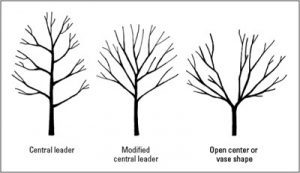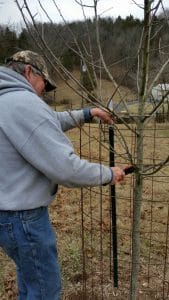How To Keep Fruit Trees Small
Pruning – February and early on March are the best time of year to prune fruit trees and grapes.
Apples and Pears (Pome Fruits) need to have a ascendant leader,  in other words, one chief trunk with side branches coming off that trunk. There are 4 situations where pruning should exist done:
in other words, one chief trunk with side branches coming off that trunk. There are 4 situations where pruning should exist done:
- Remove branches that cantankerous over each other. They may tend to rub in time and create open up wounds.
- At that place should be good infinite between branches to let sunlight and air flow around each branch. Remove a co-operative when too close together.
- Remove any watersprouts. These are shoots that grow straight up, very quickly. They are unproductive.
- Remove any suckers from around the base of the tree. These are besides

Bob pruning apple trees in February unproductive shoots that can interfere with the growth of the tree and compromise any grafts.
Peach, Nectarine, and Apricot prefer an open middle and don't unremarkably have a dominant leader. Cherry and Plum can have an open center or rounded addiction. Generally, but 4-5 main branches make upwardly these trees, leaving shorter branches to develop and produce fruit. Follow the aforementioned 4 steps in pruning for all of these Stone Fruits.
Grapes are usually grown on a trellis or fence. Severe pruning each year produces the most yield per vine. Maintain two-4 branches that will exist secured to the trellis or fence and will abound horizontally. Whatsoever branches coming off these 2-4 branches should exist cut to 2 buds.

Other small-scale fruits, such as Huckleberry, Raspberry, Blackberry, Kiwi, Gooseberry, etc are usually pruned right after they are done fruiting. This allows time for new growth to emerge in the belatedly summer and fall. Flower buds will then be set in the autumn for flowering and fruiting next spring and summer. One exception to this rule is any fall-bearing types, such as some Raspberries, and they would be pruned now.
Fallow Sprays – Any type of fruit tree or minor fruit volition benefit from dormant sprays.
- Dormant Oil should be applied in Feb – mid-March when temperatures are above freezing for a few days. Dormant Oil controls overwintering insects, such as scale, mites, webworms, and aphids, and works past suffocating the eggs. It has to exist practical earlier any new growth has emerged.
Fallow Sprays are a great way to get started on insect command but don't take care of all possible problems and should be used as a office of a regular spray program. There are three times fruit trees should exist sprayed in the spring: 1) once bloom buds are visible and most to open, 2) at petal drib (flowers are going by), and 3) two weeks afterwards petal drop. Nosotros can make recommendations on the type of spray to utilize, depending upon your personal needs and preferences.
Fertilizer – Fruits should exist fertilized at present, before growth begins. Depending upon the age of the plants, we may recommend liquid, granular, spike, or organic-type fertilizer. We tin assist yous choice out the best fertilizer for your situation.
Mulch – A fresh layer can be applied if mulch levels have reduced to the indicate that soil is showing through. Only 2-3″ is necessary to retain moisture during dry times. Mulch also adds to the organic affair levels of the soil.
Mulch helps to insulate, and if practical when the basis is frozen, will assist keep cold temperatures in the soil. Peach, Nectarine, and Apricot start to abound when soil temperatures warm up. Keeping them common cold longer volition delay the blossom and possibly avoid belatedly freezes that could destroy fruit set.
Source: https://longfellowsgarden.com/how-to/edible-gardening/care-fruit-trees-small-fruits/

0 Response to "How To Keep Fruit Trees Small"
Post a Comment